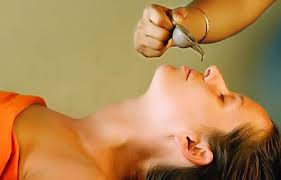 Nasya is the administration of herbal medicine through the nasal passage. According to Ayurveda, the sinus cavity is the gateway to our consciousness, Prana Vayu, and the Nervous System. Nasya is one of the five main cleansing therapies in Pancha Karma, but can also be used for daily administration as part of a healing Ayurvedic routine. Nasya is typically done using an herb-infused oil such as sesame, ghee, or coconut, but can also be done using medicated milk, fresh juice of herbs, and decoctions. Nasya is used to treat a wide range of disorders, including mental-emotional imbalances, memory issues, high-stress levels, sleep issues, chronic sinus issues, prana disorders, chronic headaches or migraines, stiffness in the neck, jaw or shoulders; eye, ear, and throat disorders; epilepsy, Parkinson’s disease, sexual debility and any residual doshic imbalance after cleansing treatments.
Nasya is the administration of herbal medicine through the nasal passage. According to Ayurveda, the sinus cavity is the gateway to our consciousness, Prana Vayu, and the Nervous System. Nasya is one of the five main cleansing therapies in Pancha Karma, but can also be used for daily administration as part of a healing Ayurvedic routine. Nasya is typically done using an herb-infused oil such as sesame, ghee, or coconut, but can also be done using medicated milk, fresh juice of herbs, and decoctions. Nasya is used to treat a wide range of disorders, including mental-emotional imbalances, memory issues, high-stress levels, sleep issues, chronic sinus issues, prana disorders, chronic headaches or migraines, stiffness in the neck, jaw or shoulders; eye, ear, and throat disorders; epilepsy, Parkinson’s disease, sexual debility and any residual doshic imbalance after cleansing treatments.
As you can see, Nasya can be used to treat quite a wide variety of disorders. Therefore, several different types of Nasya can be used for one’s various needs. Here is a quick overview of the main types of Nasya according to Ayurveda.
Main Types of Nasya Treatment
1. Bruhana Nasya
Bruhana is translated as building, and this Nasya method is used just for that. Since this is considered an anabolic treatment, it is typically useful for most Vata and Prana Vayu imbalances, while contraindicated for many Kapha disorders. Common herbs used for Bruhana Nasya include many Rasayana (rejuvenation) herbs such as Shatavari, Bala, Shankapushpi, and Ashwagandha. An appropriate base is ideally also “building” and Vata-pacifying by nature, such as herbal-infused ghee, milk, or sesame oil. For anabolic Pitta treatment options, coconut oil, ghee, sunflower oil, medicated milk, or cucumber juice can be used.
Indications for Bruhana Nasya:
- Vata imbalances
- Nervous System Disorders
- Dry sinuses or throat
- Headache due to dryness or constriction
- Sleep issues
- High-stress
- Mental exhaustion
- Restless mind
- Anxiety, worry, fear, and insecurity
- Inability to concentrate
- Tinnitus
- Stiffness in the neck, jaw, and shoulders
- Dizziness, spaciness, or vertigo
- Post-cleanse rejuvenation therapy when indicated
Contraindications for Bruhana Nasya:
- Pregnancy
- Menstruation
- Congestion
- Foggy, dull mind
- Overall heaviness
- Most Kapha disorders
- Mental toxins
2. Shamana Nasya
Shamana means pacification, and this Nasya type is used to pacify specific doshic imbalances. A Vata imbalance will often have a sesame oil base infused with grounding herbs such as Shankapushpi, Jatamansi, or Ashwagandha. Pitta disorders may indicate either ghee or coconut oil base infused with herbs such as Brahmi, Neem, Jatamansi, or Guduchi. Tikta Ghrita (bitter ghee) can also be beneficial in many Pitta conditions. Kapha disorders will need stimulating formulas using a warming oil base such as sesame oil. Herbs used for Kapha Shamana Nasya may include Vacha, Punarnava, Neem, Pippali, Black Pepper (Maricha), and Ginger.
Indications for Shamana Nasya:
- Most Vata imbalances, such as anxiety, worry, sleep issues, dryness, debility, emaciation, and epilepsy, can be pacified using the proper Vata Shamana Nasya
- Most Pitta imbalances, such as headaches, temporal migraine, psoriasis, eczema, nose bleed, MS, excessive heat, rashes, hot flashes, anger, and inflammation, can be pacified using the proper Pitta Shamana Nasya
- Most Kapha disorders, such as chronic sinus issues, congestion, dull mind, sluggishness, slow digestion, depression, and lack of motivation, can be pacified using the proper Kapha Shamana Nasya
Contraindications for Shamana Nasya:
- Pregnancy
- Menstruation
- No others if the substance used is indicated for the specific imbalance and body type
3. Navana Nasya
Navana Nasya is a lubricating Nasya application and is typically done with medicated oils for their unctuous quality. It is a form of snehana or oiliation therapy and can be used during cleanses (if indicated) or as a daily treatment. This Nasya can include the Bruhana Nasya or the Shamana Nasya. It is said to reduce stiffness in the neck, increase mental clarity and intellect, reduce dryness, and remove obstruction in the nasal passage.
Indications for Navana Nasya:
- Dryness in the eyes, nose, or throat
- Most Vata disorders
- Emotional imbalances include anxiety, worry, stress, fear, anger, and hyper-skepticism
- Mental rejuvenation
- Nervous System Disorders
- Sleep issues
- Earache
- Oiliation therapy for cleanses or daily needs
- Hair loss
- Nasal polyps
Contraindications for Navana Nasya:
- Pregnancy
- Menstruation
- No others if the substance used is indicated for the specific imbalance and body type
4. Shodhana Nasya
Shoshana Nasya is a cleansing treatment and is done using dry herbs (no oil base). Ideally, one would use a dry, powdered herb such as Vacha, Brahmi, Jatamansi, or Trikatu, depending on one’s healthcare needs. ***This can be a very intense treatment and should only be done with the guidance of a trained Ayurvedic physician.
Indications for Shodhana Nasya:
- Kapha disorders, such as chronic sinus issues, congestion, a runny nose, inflammation in the nasal passage, and a dull, foggy mind
- Poor appetite, slow metabolism, sluggish digestion
- Nasal or sinus infection
- Epilepsy
- Parkinson’s disease
Contraindications for Shodhana Nasya:
- Pregnancy
- Up to one month postpartum
- Menstruation
- If proper guidance and knowledge are not available
- Chronic cough
- Dryness in the nasal passage or throat
- Most Vata types and Vata imbalances
- Facial paralysis (Bell’s palsy)
- Emaciation, weakness, or debilitation
Once you find out the proper Nasya type that is beneficial for you, then it is time for application! Nasya can be done at various times during the day, according to your needs, current imbalances, and desired outcome. Something that will always remain the same, however, are these major contraindications of all types of Nasya:
Do Not Perform Nasya
- Up to 1 hour before or after eating
- Directly before going out into the cold weather
- Before taking a shower
- During pregnancy
- During menstruation
- Before age 7 or after age 80
- If diarrhea is present
- During a high fever
- While breathing is irregular or labored
So now you know the types of Nasya along with many reasons on when to avoid this treatment therapy. We can now move on to the “how-tos” of Nasya, as we get to the good part. Please remember to always contact a knowledgeable practitioner if you have any doubts or confusion about these powerful therapies. Just as with everything, Nasya can be medicine or poison depending on the proper or improper administration and should never be taken lightly!
How to Perform Nasya for Self-Administration
Step 1: Warm the oil.
Cold oil is never recommended for application to any part of the body. In order to warm the oil just right, I suggest placing the Nasya bottle into a large container of mildly hot (not boiling!) water until you have reached the desired temperature. It should be about body temperature or slightly cooler to avoid harming the mucus membrane.
Step 2: Lie in a comfortable area that allows the head to tilt back.
Once you have the oil ready for application, lie down on a bed or couch, allowing the head to come off the end a bit, tilting it back comfortably. You will be here for several minutes, so please make sure the neck is supported and not strained! To be extra safe, I suggest placing an old towel over your clothing to avoid any drips. Remember, oil does not come out in the washer. Also make sure the Nasya oil is nearby, as the application is the next step.
Step 3: Apply the Nasya to each nostril.
Take the warm Nasya oil and open the bottle. Squeeze the dropper “nipple”, allowing the glass dropper to fill with oil. Carefully bring this over to the right nostril. Slowly and gently, squeeze the nipple allowing the desired amount of drops to go into the right nostril. Then apply the same amount to the left nostril. Ideally, one will add an average of 1-5 drops into each nostril, depending on their specific needs. If this is your first time using Nasya, definitely begin by only applying 1-2 drops and increasing as appropriate over time.
Step 4: Take a large inhale.
After the drops have been applied, place the dropper back into the bottle and close tightly. Place the bottle to the side in a safe place. Take your hand and cover the left nostril, taking a deep inhale through the right. Then cover the right nostril, taking a deep inhale through the left.
Step 5: Sit back and allow penetration.
Now it is time to lie back. Keep the head tilted, close the eyes, and allow the Nasya to work its magic. Stay here for 1-3 minutes before slowly getting up. Feel free to blow your nose if needed.
*Please note that this information is for educational purposes. I do not recommend the practice of self-diagnosis or self-treatment without the proper knowledge or guidance. Please contact me if questions arise!
Try my Prana Nasya for emotional balance and mental rejuvenation.
Try my Soothing Sinus Nasya for sinus infection and allergies.
Try my Nidra Nasya for sound sleep.

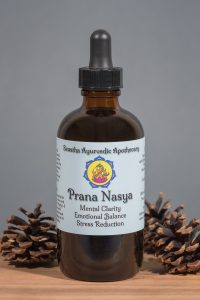
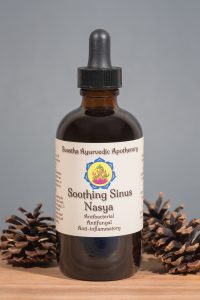
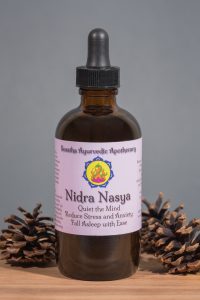
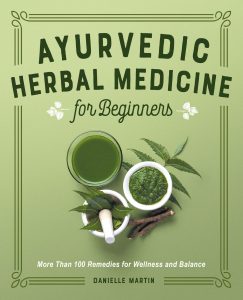

So it was my first time
I had a cold or flu like symproms for about a week and I just used the oil about 4 drops each
But the bottle stated don’t use during cold or flu, so I am worried on what’s next
Is that harmful?
Also I didn’t warm.the oIL
Hi Ayaz! Sorry for the delayed response. If there is an active sinus infection, Nasya should be avoided. If it is a chronic low grade issue, the proper Nasya can be beneficial however. The best Nasya during chronic infection will have ingredients such as Neem, Turmeric, Kalmegha and other antimicrobial, anti-inflammatory herbs in it. It is best to warm the oil slightly, but this is not mandatory unless you are using ghee or coconut oil that has solidified. Thanks for the question!
Namaste,
Danielle
Which oil is recommended for dual dosha i.e if vata pitta is imbalanced.Then?
Hi Meenakshi,
There are a handful of nasya oils that will be beneficial when dealing with a Vata-Pitta imbalance. Ghee is tridoshic and can be applied when melted. For added benefit I further recommend a Brahmi Ghee Nasya. We also carry a tridoshic nasya oil call Prana Nasya. This oil is good for all doshic imbalances and is specialized in dealing with the mind, nervous system and emotions such as anxiety, restless mind, anger, irritation, depression, etc. You can read more on Prana Nasya here. Please let me know if you have any further questions!
Namaste,
Danielle
For how many days should nasya treatment be carried out.
Hi Neena,
Thank you for your question! Nasya can be done using various methods. One may use a gentle formula such as Prana Nasya as part of their morning routine. In this sense it is safe to perform each morning indefinitely. Others may use a more specified formula such as the Soothing Sinus Nasya, which may only be needed during flare-ups, cold season or allergy season. In this sense it tends to be used more in an “as needed” basis. Nasya can also be used during cleansing therapies and is one of the main parts in Panchakarma Therapy. In this sense it is often used during the cleanse and throughout the post-cleanse period as a daily therapy (which typically is about 4-6 weeks total). The Nasya formula needed for this will depend on the individual’s specific needs.
Namaste,
Danielle
Why is menstruation a contra indication for use?
Hi Julie,
Thanks for your question! Nasya is not recommended during menstruation because the energy that is triggered during this time is Apana Vayu the downward moving wind/energy in the body. This energy is needed to allow proper flow of menstruation out of the body. Nasya application creates an opposing energy, as it triggers Prana Vayu the upward moving wind/energy. This has the potential to counteract the downward flow of menstruation and not allow the proper flushing of the female system. It is a subtle effect, but not listening to this overtime can create issues with the menstrual cycle. Thanks again for writing! Please let me know if you have any further questions.
Namaste,
Danielle
Hi…
I have a child who is 2 year 9 months of age.. I had a terrible last winter and rainy season as in he would constantly have runny nose probably allergic and later developed adenoid hypertrophy. This end of summer I started noticing similar symptoms and I started instilling a drop of warm ghee into his nostrils.. and to my surprise I am seeing some positive response.. since your post says not recommended for children below 7… I wanted to know a bit more about this.. as in what is the harm of doing it in children
Hi Supriya,
Thank you for your question! The nasya is not recommended to children under 7, mainly because of the drainage that occurs after the application. When the excess oil goes down the throat, this can cause choking in small children. If you are only using one small drop, this issue may not be relevant for your child. However, it is something to definitely look out for and be cautious of. A more safe method for small children may be to place the ghee on a q-tip and very carefully apply it to the inner nostrils (without going too far up to cause discomfort).
If your child is doing well with the ghee nasya and seems to be experiencing benefit from the method you have been applying, you may wish to continue with that at your own digression.
Please let me know if you have any further questions!
Namaste,
Danielle
Can i do nasya after excercise ?
Hi Naveen,
Thank you for your question! It is not recommended to perform nasya before exercise; however, once your breathing and heart rate have neutralized after your workout, it is safe to apply the nasya.
Please let me know if you have any further questions!
Namaste,
Danielle
Hi , why Nausa is not recommended after 80 years of age ?